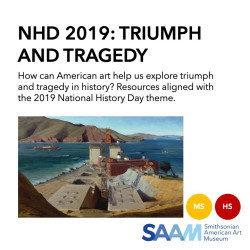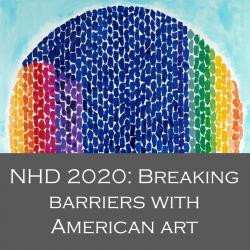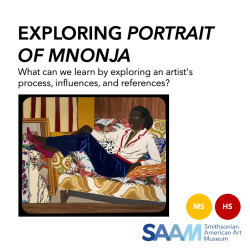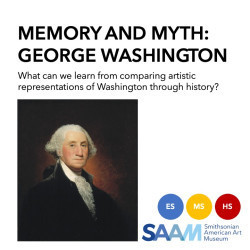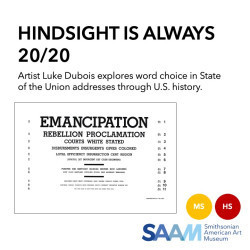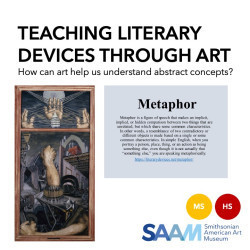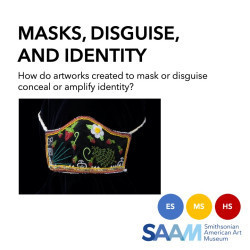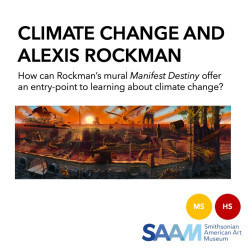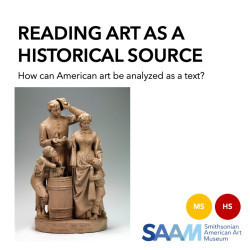Phoebe Hillemann
Teacher Institutes Educator
Smithsonian American Art Museum
As the Teacher Institutes Educator at the Smithsonian American Art Museum, I organize our week-long summer institutes for middle and high school English and social studies teachers: http://americanart.si.edu/institutes. I'm interested in interdisciplinary thinking, arts integration, and the power of dialogue in learning spaces.
Phoebe Hillemann's collections
Do Ho Suh: Almost Home
<p>Do Ho Suh’s immersive architectural installations—unexpectedly crafted with ethereal fabric—are spaces that are at once deeply familiar and profoundly alien. Suh is internationally renowned for his “fabric architecture” sculptures that explore the global nature of contemporary identity as well as memory, migration, and our ideas of home.</p>
<p>Suh was born in Korea and moved to the United States at the age of 29 in 1991, and he currently lives between New York, London, and Seoul. He crafts his works using traditional Korean sewing techniques combined with 3-D modeling and mapping technologies. Suh sees these works as “suitcase homes,” so lightweight and portable they can be installed almost anywhere.<br /></p>
<p>Essential Questions:</p>
<ul><li>What is home?
</li><li>How does perspective-taking help us better understand people, events, or issues?</li><li>How can artwork be used as a provocation for the exercise of higher order thinking and transdisciplinary application of content?</li></ul><p>Created for a program with the National Teachers of the Year on April 30, 2018.</p>
<p>#NTOY18</p><p><em>#visiblethinking</em><br /></p>
 Phoebe Hillemann
Phoebe Hillemann
13
NHD 2019: Triumph and Tragedy in American Art
<p>This collection is designed to support teachers and students exploring the 2019 National History Day theme: Triumph and Tragedy in History. Included in this collection are four prospective topics aligned with the NHD theme, for each of which we have supplied American artworks that could be used as primary source texts and/or inspiration for further research.</p>
<p>Was George Catlin's Indian Gallery an artistic triumph or exploitation of tragedy? How did the expansion of the railroad in the U.S. lead to both triumph and tragedy? How did the Public Works of Art Project (PWAP) -- the first New Deal program supporting American artists -- create triumph out of the tragedy of the Great Depression? And finally, how was the fight for African American civil rights shaped by triumph and tragedy?</p>
<p>#NHD2019 #NHD</p>
 Phoebe Hillemann
Phoebe Hillemann
41
NHD 2020: Breaking Barriers with American Art
<p>This collection is designed to support teachers and students exploring the 2020 National History Day theme: Breaking Barriers in History. Included in this collection are five prospective topics aligned with the NHD theme, for each of which we have supplied American artworks that could be used as primary source texts and/or inspiration for further research.</p>
<p>How did the invention of photography break down the barrier between ordinary Americans and the battlefield during the Civil War? </p>
<p>What barriers, both geographic and social, did the invention and expansion of the subway break for New Yorkers? </p>
<p>How did James Van Der Zee's Harlem photography studio help a rising middle class African American community break barriers?</p>
<p>How have American Indians overcome barriers to tribal sovereignty, and what barriers still exist?</p>
<p>How did abstract painter Alma Thomas break gender and racial barriers in the art world?</p>
<p>#NHD2020 #NHD #BecauseOfHerStory</p>
 Phoebe Hillemann
Phoebe Hillemann
55
Teaching Literary Devices through Art
<p>A good visual can often be the key to understanding (and remembering) a seemingly abstract concept. This collection demonstrates how artworks in the Smithsonian American Art Museum may be used to teach common literary devices in the English/language arts classroom such as metaphor, irony, symbolism, and more.</p>
<p>Key words: allegory, allusion, anthropomorphism, foreshadowing, irony, juxtaposition, metaphor, mood, motif, satire, suspense, symbol</p>
 Phoebe Hillemann
Phoebe Hillemann
30
Masks, Disguise, and Identity
<p>Explore pieces created to mask or disguise, from Nick Cave's Soundsuits to masks made during the Covid-19 pandemic. How do these works conceal or amplify identity (of the wearer, or the artist)? How do they relate to history and culture? </p>
<p>Resource created for a September 30, 2021 Artful Teaching Moments program led by the Smithsonian American Art Museum.</p>
 Phoebe Hillemann
Phoebe Hillemann
15
Cultural Imagery and Stereotypes: The American Experience in the Classroom
<p>This collection focuses on two works that deal with the issues of nationality, identity and the assimilation of cultures. Mel Casas's pun-laced <em>Humanscape 62</em> combines elements familiar to many Americans: brownie desserts and a young Girl Scout (a Brownie), with traditional Mexican imagery. This pop art style-blend illustrates the Chicano experience to American culture and creates a push and pull narrative about Latino identity. Similarly, Roger Shimomura, an American-born artist of Japanese descent, contemplates repressed emotions from the time he and his family spent in World War II-era Japanese internment camps, following the attack on Pearl Harbor.</p>
<p>#APA2018</p>
<p><a href="http://americanexperience.si.edu/historical-eras/contemporary-united-states/pair-humanscape-diary-december-12/">http://americanexperience.si.edu/historical-eras/c...</a> </p>
 Phoebe Hillemann
Phoebe Hillemann
14
NCSS 2019: Teaching for Global Competence through American Art
<p>Resources used during a session at the National Council for the Social Studies (NCSS) annual conference in Austin, TX on November 23, 2019.</p>
<p>Essential Question: How can visual art nurture students' capacities to take informed action as citizens in a complex, interconnected world?</p>
 Phoebe Hillemann
Phoebe Hillemann
8
SAAM General Resources
<p>This collection was created for the Smithsonian Summer Sessions for Teachers in July 2020, and contains resources related to the Smithsonian American Art Museum's breakout session as well as additional education resources for teachers and students.<br></p>
<p>#SummerSessions</p>
 Phoebe Hillemann
Phoebe Hillemann
30
#BecauseOfHerStory: The Power of Posters
<p>Resources supporting a January 7, 2021 teacher workshop led by the National Portrait Gallery and Smithsonian American Art Museum. </p><p>Posters and prints are an immediately accessible and iconic art form; they are in our bedrooms, our classrooms, and in the protests in our streets. What can we learn from the way posters communicate visually? </p>
 Phoebe Hillemann
Phoebe Hillemann
28
The Subway
Artworks, photographs, and other documents relating to the New York subway system.
 Phoebe Hillemann
Phoebe Hillemann
8
No Spectators: The Art of Burning Man
<p>Each year in Nevada’s Black Rock Desert, a city of more than 70,000 people rises out of the dust for a single week. During that time, enormous experimental art installations are erected and many are ritually burned to the ground. The thriving temporary metropolis known as Burning Man is a hotbed of artistic ingenuity, driving innovation through its principles of radical self-expression, decommodification, communal participation, and reverence for the handmade. Both a cultural movement and an annual event, Burning Man remains one of the most influential phenomenons in contemporary American art and culture.<br /></p>
<p><em>No Spectators: The Art of Burning Man, </em>an exhibition at the Smithsonian's Renwick Gallery, brings the large-scale, participatory work from this desert gathering to the nation’s capital for the first time. This collection features video interviews with many of the artists whose artwork is featured in the show.</p><p><br /></p><p>Keywords: STEM, STEAM, Design Thinking, Installation Art, Public Art</p>
 Phoebe Hillemann
Phoebe Hillemann
17
William H. Johnson's Fighters for Freedom
<p>In the <em>Fighters for Freedom</em> William H. Johnson created a pantheon of historic and contemporary leaders who dedicated their lives to racial justice, individual accomplishment, and social equality. The series features African American abolitionists, scientists, teachers, performers and sports figures, and momentous meetings of allied heads of state.</p>
<p>Collection created to support a session at the 2021 National Council for Social Studies (NCSS) virtual conference.</p>
 Phoebe Hillemann
Phoebe Hillemann
31


